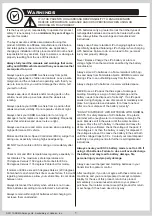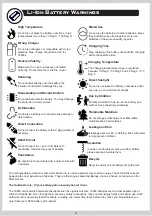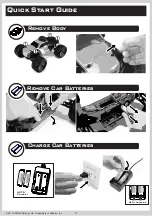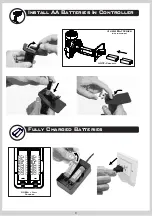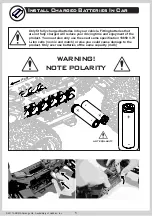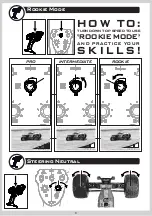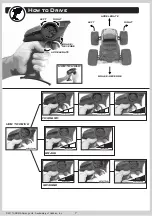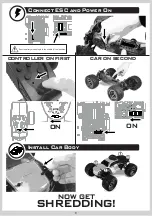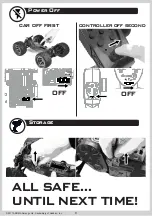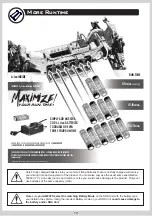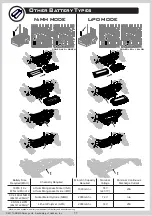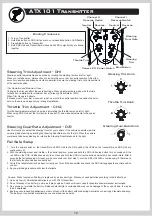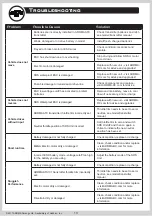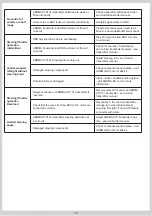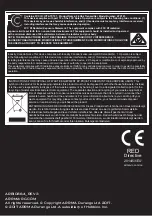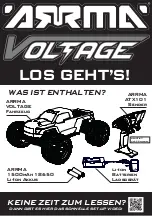
© 2017 ARRMA Durango Ltd. A subsidiary of Hobbico, Inc.
Warnings
IT IS THE PARENTS OR GUARDIANS RESPONSIBILITY TO ENSURE MINORS
RECEIVE APPROPRIATE GUIDANCE AND/OR SUPERVISION WHEN USING OR
WORKING ON THIS PRODUCT.
It is the buyer’s (your) responsibility to operate this product
safely. It is necessary to be a
minimum 14 years of age
to
operate this model.
The buyer assumes all risk associated with using this
product. ARRMA, its affiliates, manufacturers, distributors,
and retail partners cannot control the use, application,
charging or installation of this product and shall not be held
responsible for any accident, injury to persons or damage to
property resulting from the use of this product.
Always fully read the manuals and warnings that come
with your ARRMA vehicle and with any accessories that
are required to run it.
Always operate your ARRMA vehicle away from public
highways, bystanders, children and animals. Leave a safe
margin around the vehicle when operating such that if you
were to lose control, you will not damage the vehicle, hurt
yourself or others.
Always keep clear of wheels and/or moving parts on the
vehicle, never pick-up a vehicle when the wheels are
rotating.
Always operate your ARRMA vehicle from a position that
allows maximum visibility. Do not operate vehicle at night.
Always check your ARRMA vehicle prior to running. If
damage is found, replace or repair immediately. Frequently
check that all screws and wheel nuts are tight.
Always use due care and common sense when operating a
high performance RC vehicle.
Motors and Electronic Speed Controllers (ESCs) will get hot
during use, especially running high-speed gearing.
DO NOT touch motors or ESCs during or immediately after
use.
Check motor and ESC temperatures regularly, especially in
hot climates. The maximum safe temperatures are:
70 degrees Celsius / 158 degree Fahrenheit for ESCs.
80 degrees Celsius / 176 degrees Fahrenheit for motors.
If motors or ESCs exceed 95 degrees Celsius / 200 degrees
Fahrenheit it can shorten their life or cause failure. If in doubt
regarding temperatures, allow your vehicle time to cool down
between runs.
Always disconnect the battery when vehicle is not in use.
Store batteries according to manufacturer’s instructions.
Always remain within sight of batteries whilst charging; do
not leave them unattended.
LiPo batteries carry a greater fire risk than other types of
rechargeable batteries and need to be treated with extra
care. Always follow the warnings and manufacturers’
instructions.
Always use a flame retardant LiPo charging bag/box and a
specifically designed balancing LiPo charger when charging
LiPo batteries. Failure to do so can lead to fire, personal
injury and property damage.
Never ‘Balance Charge’ the LiPo battery at a rate or
voltage higher than the maximum specified by the battery
manufacturer.
Always store LiPo batteries in a flame retardant LiPo bag/
box and away from flammable objects. ARRMA recommend
storing LiPos in an outbuilding away from the home.
Always charge LiPo batteries in a well-ventilated space.
NEVER use a LiPo pack that has signs of damage or
swelling. Swelling is a sign of internal damage and the
battery needs to be disposed of correctly*. If a LiPo pack
swells during charging or use, disconnect immediately and
place in an open area and observe for at least one hour.
After one hour dispose of the battery correctly*.
*DO NOT DISPOSE OF LIPO BATTERIES WITH NORMAL
WASTE. To safely dispose of LiPo batteries, fill a plastic
container with enough water to completely submerge the
pack. Dissolve salt in the water until the water becomes
opaque. Place the LiPo battery in the water and leave for
24hrs. Using a voltmeter, check the voltage of the pack; if
the voltage is 0.0v then the battery is ready for disposal. If
the voltage is above 0.0v, leave the battery in the salt bath
until the voltage drops to 0.0v. Contact your local disposal
authority or recycling centre for further recycling/disposal
instructions.
Always ensure your ESC’s battery mode is set to LiPo if
using LiPo batteries. Failure to do so will over-discharge
the battery and may lead to battery damage, fire,
personal injury and property damage.
Always use new/charged and matching batteries in your
transmitter for optimum control.
After reading all, if you do not agree with these terms and
conditions, and you are not prepared to accept complete
liability for the use of this product, return this product
immediately in a new/unused condition to your place of
purchase. Your retailer cannot accept this product for return
or exchange if it has been used in any way.
1


